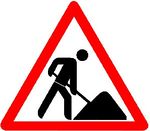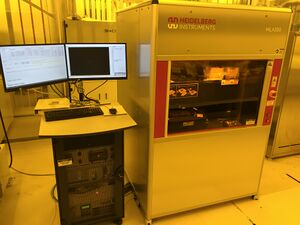Maskless Aligner (Heidelberg MLA150): Difference between revisions
(→About: updated some specs) |
(Added photo) |
||
| Line 1: | Line 1: | ||
{{WIP}} |
{{WIP}} |
||
{{tool|{{PAGENAME}} |
{{tool|{{PAGENAME}} |
||
|picture= |
|picture=MLA150_Heidelberg_Bay_6_Photo.jpg |
||
|type = Lithography |
|type = Lithography |
||
|super = Biljana Stamenic |
|super = Biljana Stamenic |
||
Revision as of 23:29, 2 October 2020
Work In Progress This article is still under construction. It may contain factual errors. Content is subject to change. |
|
About
The MLA150 allows for arbitrary direct patterning of I-Line photoresists, directly from a CAD drawing/file, with alignment to arbitrary features on the sample. The system uses a digital micromirror device ("DMD", an array of MEMS mirrors) for patterning the exposure light-field, to programmatically expose digitized patterns directly onto the sample - no glass photomasks/reticles are required.
The system has a continuous, automatic autofocus, using either a pneumatic or optical detection. This enables lithography on non-planar or curved substrates. We also have the high-aspect ratio (variable/long focal length) option installed for very thick (~70µm) photoresists.
Depending on the exposure options and write area, MLA is able to expose a 100mm wafer in about 30min, and achieves minimum features sizes around 0.5µm, with overlay/alignment accuracy better than 200nm.
Lastly, the greyscale lithography is possible, producing repeatable, slanted or tapered structures in photoresist or photo-active dielectrics like SU-8.
Detailed Specifications
- Wafer size:
- Wafer / substrate thickness:
- Exposure optics:
- Laser #1: 375nm
- Laser #2: 405nm
- Focus modes:
- Alignment:
- Modes?
- Accuracy:
- Repetability
- Additional manufacturer options:
- Focus option?
- Dual lasers?
- High-resolution option?
- Uniformity:
- Write speeds:
Documentation
Design Tools/Info
Recipes
- Recipes > Lithography > Maskless Aligner MLA150
- Starting recipes for various I-Line photoresists

